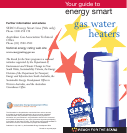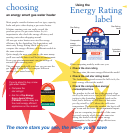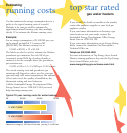
choosing
Most people consider features such as type, capacity,
looks and price when buying a gas water heater.
Lifetime running costs can easily exceed the
purchase price of a gas water heater. So, it’s
important to also check the energy efficiency and
running costs when shopping around.
All new gas water heaters are rated for energy
efficiency by the Australian Gas Association, and
most carry Energy Rating labels to help you
compare the energy efficiency of different models in
the same situation.
Quite simply, the more stars you see, the more money
you’ll save and the better it will be for our environment.
Even a one star improvement can give savings of
around 6% on running costs.
This consumer guide tells you how you can use the
gas Energy Rating labels to compare different
models of gas water heaters.
an energy smart gas water heater
Star Rating
Comparative
energy
consumption
box
Australian
Standard
Star Rating
band
Using the
Energy Rating
label
When comparing models, make sure you:
• Check the star rating
The more stars, the more energy efficient the model.
• Check the red star rating band
The further this extends across the half circle, the
more energy efficient the model.
• Check the comparative energy
consumption box
The number in the red box is the amount of gas
used by the unit over a year (in MJ). It is based on
testing to the Australian Standard listed on the
label, and a delivery of 200 litres of hot water
per day, raised by 45ºC above the cold water
temperature. The lower the number, the less it will
cost to run and the lower the environmental impact.
If you are comparing two models of the same
type and capacity which have the same star
rating, the model with the lower energy
consumption is the more energy efficient one.
Based on a usage of 200 litres of hot water per day, 2.1c/MJ tariff
$0 $2,000 $4,000 $6,000
Typical 12-year running costs for water heaters
5 star model
3 star model
Estimating
running costs
Use the number in the energy consumption box as a
guide to the typical running costs of a model.
Multiply it by your gas tariff to estimate the
approximate annual running costs, then multiply
this by 12 to estimate the lifetime running costs.
Example:
For an energy consumption of 21,500 MJ per year
and a natural gas tariff of 2.1 cents per MJ
($0.021/MJ), the lifetime running cost is:
21,500 x $0.021 x 12 = $5,418
The labels can also be used to estimate the lifetime
greenhouse gas emissions. For each MJ of gas
consumed, around 0.06 kg of carbon dioxide is
emitted, so for the example above the greenhouse
gas emissions are:
21,500 x 0.06 x 12 = 15,480 kg or 15.48 tonnes
The actual running costs and greenhouse gas
emissions will depend on where you live, your gas
type and tariff, cold water temperatures, the amount
of hot water used, the quality of installation, the
thermostat setting and user behaviour.
Call the Sustainable Energy Development Office
Energy Smart Line on 1300 658 158 if you need
help estimating running costs.
top star rated
gas water heaters
If you would like details on models on the market,
contact the appliance supplier or your local gas
appliance retailer.
If you want more information on choosing a gas
water heater to suit your needs, contact the
Sustainable Energy Development Office Energy
Smart Line on 1300 658 158.
If you want more information on gas Energy Rating
labels, contact the Australian Gas Association’s
Technical Office on:
Telephone (03) 9580 4500
For more information on Top Energy Saver Award
Winner winning appliances log onto the Top Energy
Saver Award Winner web site:
www.energyrating.gov.au/tesaw-main.html.
If you’re about to buy a new
gas water heater:
• Compare the
star ratings!
• Ask for a Top Energy
Saver Award Winner
(TESAW) model—they are
the most energy efficient
appliances on the market!
The more stars you see, the more you’ll save
A joint
government &
industry program
ENERGY
ENDORSEMENT
WINNER 2004
T
O
P
E
N
E
R
G
Y
S
A
V
E
R
A
W
A
R
D
Sirocco Saraha Clothes Washer
Model SS120
This label is awarded to appliances that are
among the most energy efficient on the
market in their class at the time of testing.
For more information and to compare
appliances, refer to:
www.energyrating.gov.au






